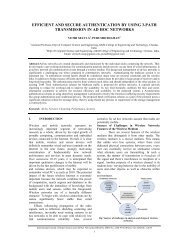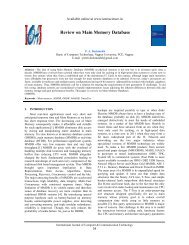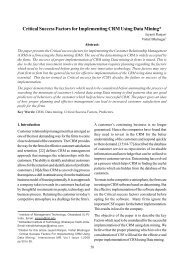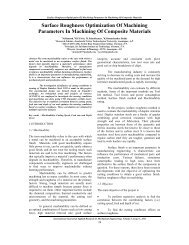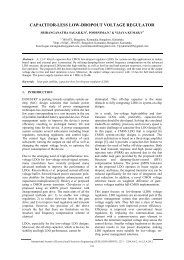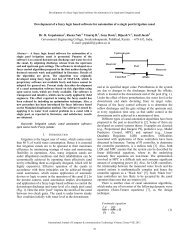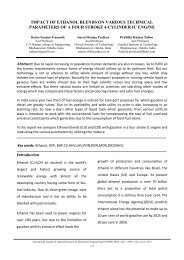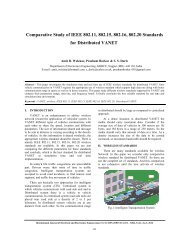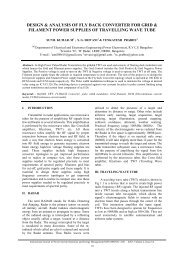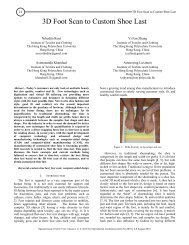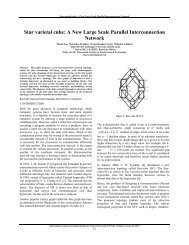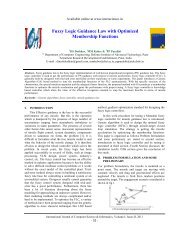Disease Diagnosis System
Disease Diagnosis System
Disease Diagnosis System
Create successful ePaper yourself
Turn your PDF publications into a flip-book with our unique Google optimized e-Paper software.
V. METHODOLOGY<br />
Methodology for development of th the CADRE is<br />
given as under.<br />
• SCOPE & LIMITATIONS<br />
The diagnosis deals with followi wing common<br />
diseases:<br />
Malaria, Chicken pox, Diarrhoea, Diabe betics, Cholera,<br />
Jaundice, Hepatitis, Typhoid, , Thyroid,<br />
Alzeimer’s<strong>Disease</strong>, Bronchitis, Migraine, , Scatia S<br />
• KNOWLEDGE ACQUISITION<br />
Searching for relevant books, , libraries and<br />
World Wide Web (WWW).<br />
Meetings with ophthalmologis gists, medical<br />
students and patients.<br />
Personnel observations and getting ing historical<br />
data from various ophthalmology y cclinics,<br />
depts.<br />
and wards in hospital, free eye cam amps, other<br />
health care units and medical colle lleges.<br />
• KNOWLEDGE REPRESENTATION<br />
Using production rules facilitated d bby<br />
MATLAB<br />
Storing additional information using u external<br />
database.<br />
• SOFTWARE DEVELOPMENT<br />
Different software modules, like: MMATLAB,<br />
MS<br />
Excel, Visual Basic, were integrated to develop the<br />
software. Validity of software was checke cked for sample<br />
data being acquired through various sources ces.<br />
• IMPLEMENTATION & MAINTENAN ANCE<br />
Expanding scope of the system by gi giving it inputs<br />
from different sources like World Wide de Web, recent<br />
research conducted in the field of op ophthalmology.<br />
Implementation of software in different ent health care<br />
depts.: e.g. hospitals, clinics medical colle ollege labs, free<br />
camps etc.<br />
VI. SCREENSHOTS<br />
Fig:- Input Scree<br />
<strong>Disease</strong> <strong>Diagnosis</strong> <strong>System</strong> �<br />
�<br />
International Journal of f Computer C Science & Informatics, Volume-I, Issue-II, 201 011<br />
��<br />
�<br />
Fig:- User Interface<br />
Fig: Acccuracy Level of the he system<br />
VII. CONCLUSION<br />
In this paper, a case-based med edical expert system<br />
prototype that supports diagnosis of Common diseases<br />
was developed. Several properties of this model remain<br />
to be investigated. It should be teste sted on several more<br />
databases. Unfortunately databas ases are typically<br />
proprietary and difficult to obtain. FFuture<br />
prospects for<br />
medical databases should be good si since some hospitals<br />
are now using computerized record rd systems instead of<br />
traditional paper-based. It should d be fairly easy to<br />
generate data for machine diagnos osis. One important<br />
aspect of automated diagnosis is the accompanying<br />
explanation for the conclusion, a fact actor that is important<br />
for user acceptance. A trained expert ert would evaluate the<br />
quality of the diagnosis performe med by the system,<br />
followed by adjustment of the ut utilities. Knowledge<br />
structure was represented via a fo formalism of cases.<br />
Cardiologists evaluate the system perf erformance by testing<br />
it practically for 13 new cases s where the system<br />
succeeded in estimating the correct t diagnosis. d For future<br />
work, more cases will be added to the th case memory and<br />
it will be clinically tested.



